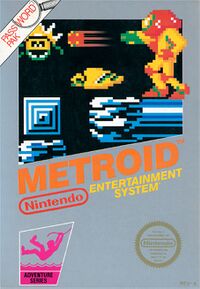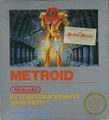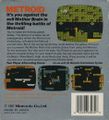Navigation menu
Metroid (game)
| ||||||||||||||||||||||
| ||||||||||||||||||||||
| This article is about Metroid, the first Metroid game. For other uses, see Metroid (disambiguation). |
Metroid is the first game of the Metroid series, both chronologically, and in release order. It was released for the Famicom Disk System in August 1986, with a Nintendo Entertainment System version following a year later.
Story[edit | edit source]
A deep-space research vessel is sent by the Galactic Federation (a congress composed of representatives from several planets in the galaxy) to retrieve a new lifeform discovered in suspended animation on Planet SR388, dubbed Metroid. As they returned, however, the vessel was attacked by Space Pirates, who stole the capsule containing the Metroid and took it to their fortress on Planet Zebes.
Recognising the potential threat of the Metroids as Space Pirate weapons if allowed to multiply via exposure to beta rays, the Federation attempts an attack on Zebes, but is repelled. As a last resort, they hire Samus Aran to infiltrate Zebes alone, with the intention of stopping the Space Pirates from creating more Metroids and defeating the Pirate leader on Zebes, Mother Brain.
After arriving in Brinstar, Samus traverses the planet's underworld in search of two high-ranking Space Pirates, Kraid and Ridley, both of whom she eventually locates and destroys. Following this, she is given access to Tourian, the main Space Pirate headquarters on Zebes. Though by now filled with Metroids, Samus dispatches them and confronts Mother Brain, destroying her. Although a time bomb threatens to destroy Tourian following Mother Brain's defeat, Samus manages to escape before it detonates and takes every last Metroid with it.
Gameplay[edit | edit source]
Metroid is a 2D action platformer. Unlike other platformers, in which there are several levels with defined start and end points, the entire world is large and open-ended, with players free to access new areas and return to old ones as they see fit. Though Samus starts off with only the ability to jump and a weak, short-ranged weapon, she can improve her abilities by finding various upgrades scattered throughout planet Zebes, such as the Long Beam to improve her weapon's range and the Morph Ball to access small tunnels.
These upgrades are vital to progressing in the game, as several areas can only be reached by obtaining a certain upgrade. In addition, Samus can find Energy Tanks and Missile Tanks to carry more health and missiles, which are occasionally dropped as power-ups by defeated enemies. Though the player's goal is to enter Tourian, the area is off-limits to them until they find and defeat Kraid and Ridley, who are located in hideouts beneath Brinstar and Norfair and serve as the game's boss encounters.
The original Famicom Disk System version allows players to save their progress. The Nintendo Entertainment System version, however, uses a password system to allow players to continue where they left off after the game is restarted by giving them a specific password upon death. The game keeps track of how long it takes the player to beat the game; depending on their time, they will get one of five endings:
- 10 or more hours: Samus covers her face and turns her back to the player.
- Under 10 hours: Samus faces the player with one arm raised in the air.
- Under 5 hours: Samus removes her helmet, revealing her true face.
- Under 3 hours: Samus removes her Power Suit, and is seen in a leotard.
- Under 1 hour: Samus removes her Power Suit, and is seen in a bikini.
Should the player achieve either of the latter two endings in the NES version, they will be able to restart the game with Samus outside of her Power Suit and all upgrades they previously had (excluding Energy and Missile Tanks). However, the difference is purely cosmetic and doesn't affect regular gameplay.
Locations[edit | edit source]
Reception[edit | edit source]
Reception for Metroid has been largely positive, and its reception has spawned multiple sequels, a manga, and a fanbase. Metroid has shipped over 2.7 million copies globally.
The magazine also named Metroid called it the fifth-best game for the Nintendo Entertainment System in its Best of the Best feature, describing it as a combination of Super Mario Bros.'s platforming and The Legend of Zelda's exploration and character upgrades. On Top 100 Games lists, the game was ranked 69th by Electronic Gaming Monthly, and 6th by Game Informer then 7th in 2009 by Game Informer. Game Informer also put Metroid 7th on their list of "The Top 200 Games of All Time", saying that it "started the concept of open exploration in games". GamesRadar ranked it the fifth best NES game ever made.
Later Releases and Remakes[edit | edit source]
Metroid: Zero Mission[edit | edit source]
Released in 2004 for the Game Boy Advance, Metroid: Zero Mission is a remake of the original game featuring enhanced graphics, significant gameplay alterations, as well as additional content not found in the original. Completing the game unlocks the original Metroid.
NES Remix Series[edit | edit source]
Starting in NES Remix 2, released in 2014 for the Wii U eShop, Metroid is included within the list of games used for its challenges. Metroid would continue to be included in NES Remix Pack (a collection of the first two games) and Ultimate NES Remix (a "Best of" selection from the first two games).
Other rereleases[edit | edit source]
- Classic NES Series: Released as a part of a series of NES and Famicom games ported to the Game Boy Advance.
- Virtual Console: A downloadable title from the Wii's Wii Shop Channel, costing 500 Wii points. Later released on 3DS and Wii U as downloadable titles on both systems' eShop. The 3DS release was offered for free to members of the 3DS Ambassador Program. The electronic manual for the 3DS version describes the secret method of saving involving using the second player's controller.
- Super Smash Bros. for Wii U: A timed 3 minute trial of Metroid is included as one of the included masterpieces.
- Amiibo Tap: A free piece of software for the Wii U that allowed for the playing of 3 minute trials for different NES and SNES games through the scanning of Amiibo. Metroid is included as one of the demos that can be unlocked. Tapping the Amiibo during the trial will load a new scene.
- NES Classic Edition: Included as a built in game.
- Nintendo Switch Online: Added as part of the service on November 14, 2018.
Credits[edit | edit source]
See Credits: Metroid for more information.
Gallery[edit | edit source]
-
European cover art (front)
-
European cover art (back)
-
Title screen
External Links[edit | edit source]
| 2D Games | |
| 3D Games | |
| Other Games | |



